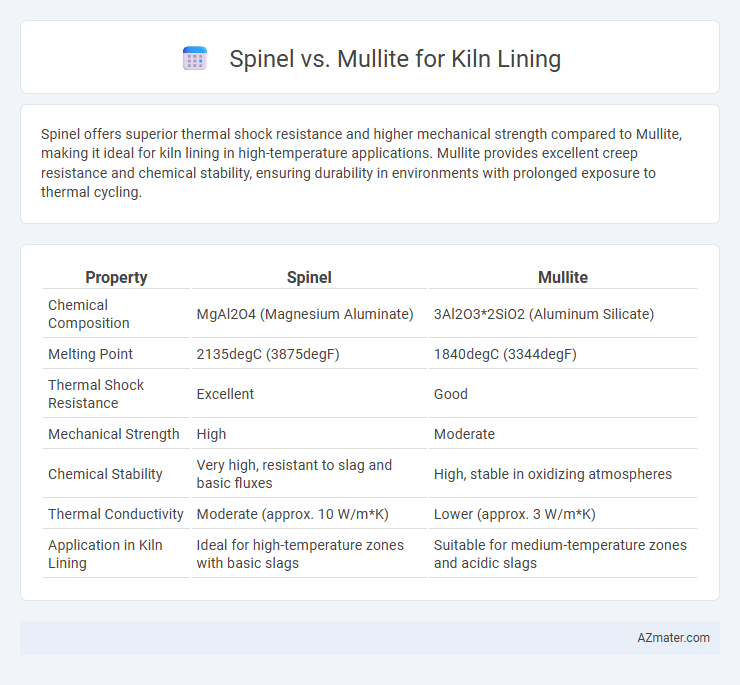Spinel offers superior thermal shock resistance and higher mechanical strength compared to Mullite, making it ideal for kiln lining in high-temperature applications. Mullite provides excellent creep resistance and chemical stability, ensuring durability in environments with prolonged exposure to thermal cycling.
Table of Comparison
| Property | Spinel | Mullite |
|---|---|---|
| Chemical Composition | MgAl2O4 (Magnesium Aluminate) | 3Al2O3*2SiO2 (Aluminum Silicate) |
| Melting Point | 2135degC (3875degF) | 1840degC (3344degF) |
| Thermal Shock Resistance | Excellent | Good |
| Mechanical Strength | High | Moderate |
| Chemical Stability | Very high, resistant to slag and basic fluxes | High, stable in oxidizing atmospheres |
| Thermal Conductivity | Moderate (approx. 10 W/m*K) | Lower (approx. 3 W/m*K) |
| Application in Kiln Lining | Ideal for high-temperature zones with basic slags | Suitable for medium-temperature zones and acidic slags |
Introduction to Kiln Lining Materials
Spinel and Mullite are essential refractory materials widely used in kiln lining due to their high-temperature stability and thermal shock resistance. Spinel, a magnesium aluminate compound, offers superior corrosion resistance and mechanical strength ideal for harsh kiln atmospheres. Mullite, an alumino-silicate mineral, provides excellent thermal insulation and low thermal expansion, making it suitable for energy-efficient kiln linings.
Overview of Spinel: Properties and Applications
Spinel is a refractory material known for its excellent thermal stability, high melting point of approximately 2135degC, and superior resistance to chemical corrosion, making it ideal for kiln lining applications. Its dense, crystalline structure enables exceptional mechanical strength and abrasion resistance, which enhances the durability and longevity of kiln linings in high-temperature environments. Widely used in industries such as steel manufacturing and ceramics, Spinel provides efficient thermal insulation while maintaining structural integrity under extreme thermal cycles.
Overview of Mullite: Properties and Applications
Mullite is a highly stable aluminosilicate ceramic known for its excellent thermal shock resistance, low thermal expansion, and outstanding mechanical strength at high temperatures. It typically features a melting point above 1830degC and retains structural integrity, making it suitable for kiln linings in industries such as ceramics, metallurgy, and glass manufacturing. Its chemical inertness and resistance to slag and corrosion ensure durability and prolonged service life under severe thermal cycling conditions.
Thermal Stability: Spinel vs Mullite
Spinel exhibits superior thermal stability compared to mullite, maintaining structural integrity at temperatures exceeding 1600degC, while mullite typically operates effectively up to around 1500degC. The dense crystalline structure of spinel provides enhanced resistance to thermal shock and chemical corrosion in kiln linings. Mullite's lower thermal expansion reduces the risk of cracking but makes it less durable in extreme high-temperature environments compared to spinel.
Chemical Resistance Comparison
Spinel exhibits superior chemical resistance to acidic slags and alkalis compared to mullite, making it highly effective in aggressive kiln atmospheres. Mullite shows excellent resistance to thermal shock but is more susceptible to corrosion from molten silicates and acidic fluxes. The enhanced stability of spinel in corrosive environments significantly extends kiln lining life and reduces maintenance costs.
Mechanical Strength and Durability
Spinel offers superior mechanical strength and thermal shock resistance compared to mullite, making it highly effective for kiln lining under extreme temperature fluctuations. Mullite provides excellent thermal stability and resistance to chemical attack but generally exhibits lower mechanical strength, which can reduce its durability in high-stress kiln environments. The choice between spinel and mullite depends on the specific requirements for mechanical load and chemical exposure, with spinel favored for enhanced durability and structural integrity.
Thermal Shock Resistance Analysis
Spinel and Mullite are critical materials for kiln linings, with Spinel exhibiting superior thermal shock resistance due to its higher thermal conductivity and structural stability at elevated temperatures. Spinel's ability to withstand rapid temperature fluctuations without cracking stems from its dense crystalline structure and low thermal expansion coefficient, making it ideal for aggressive thermal cycling environments. In contrast, Mullite offers good thermal shock resistance but generally underperforms compared to Spinel, especially in scenarios involving extreme thermal gradients and prolonged high-temperature exposure.
Cost-Effectiveness and Availability
Spinel offers superior thermal stability and resistance to slag attack, but its higher raw material costs and limited availability often increase overall kiln lining expenses. Mullite, known for its abundant natural sources and lower price, provides adequate thermal shock resistance and structural integrity, making it a more cost-effective option for general kiln linings. Evaluating the balance between initial investment and long-term durability is essential when selecting Spinel or Mullite based on operational needs and budget constraints.
Case Studies: Spinel and Mullite in Industrial Kilns
Case studies in industrial kilns demonstrate that spinel offers superior thermal shock resistance and enhanced corrosion protection compared to mullite, resulting in longer service life under harsh operating conditions. Mullite, while cost-effective and exhibiting good thermal stability, often shows faster degradation in environments with aggressive slags and fluxes. The data indicates spinel-based linings reduce downtime and maintenance costs, proving their effectiveness in high-performance kiln applications.
Choosing the Best Kiln Lining: Spinel or Mullite?
Spinel offers exceptional thermal stability and resistance to slag corrosion, making it ideal for high-temperature kiln linings exposed to aggressive environments. Mullite provides excellent thermal shock resistance and mechanical strength, ensuring durability and long service life in varying thermal cycles. Choosing between Spinel and Mullite depends on the specific kiln operating conditions, with Spinel preferred for corrosive atmospheres and Mullite favored for applications requiring superior thermal shock resilience.

Infographic: Spinel vs Mullite for Kiln lining
 azmater.com
azmater.com